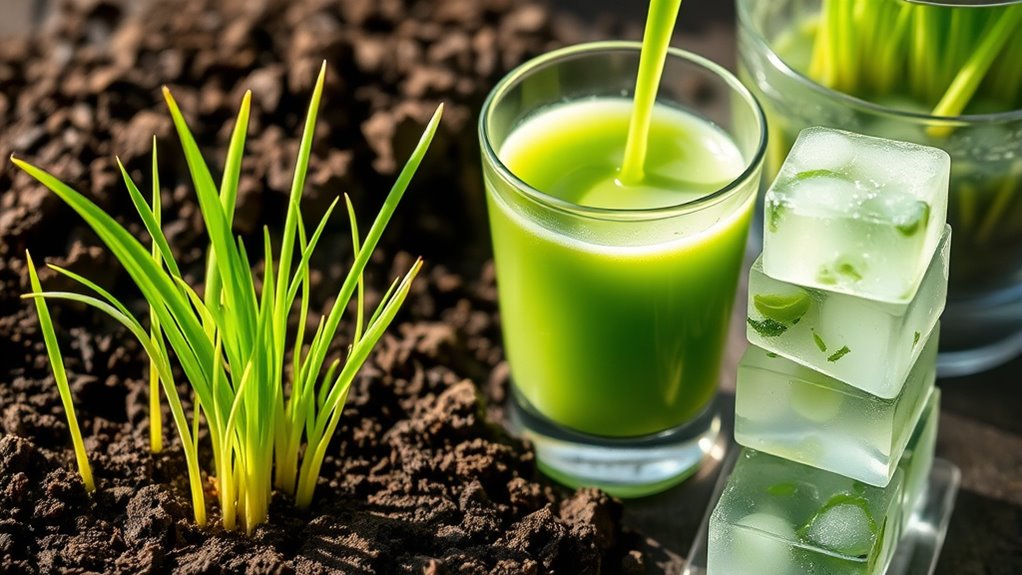To make wheatgrass shots, you should grow your wheatgrass until it’s about 7-10 inches tall, then cut just above the roots using sharp shears to encourage regrowth. Rinse thoroughly before juicing with a blender or juicer, and freeze leftover juice in ice cubes for convenient, long-lasting nutrient boosts. Proper harvesting, juicing, and freezing techniques help maximize nutrients, so keep exploring for more tips on growing, harvesting, and enjoying your wheatgrass at its freshest.
Key Takeaways
- Grow wheatgrass to 7-10 inches, then cut just above the roots using sharp scissors for optimal nutrient preservation.
- Rinse harvested wheatgrass thoroughly before juicing to ensure cleanliness and maximum health benefits.
- Juice wheatgrass using a juicer or blender, strain for smoothness, and freeze in ice cube trays for convenient storage.
- Freezing slightly reduces nutrients but preserves most benefits; transfer juice cubes to sealed bags for long-term storage.
- Incorporate fresh or frozen wheatgrass into daily routines to maximize health benefits from nutrients and antioxidants.

Wheatgrass shots have become a popular way to boost your health in a quick and convenient form. If you’re growing your own wheatgrass, understanding effective harvesting techniques is key to getting the most out of your crop. When harvesting, you want to wait until your wheatgrass reaches about 7 to 10 inches in height, which usually takes around 7 to 10 days after sprouting. Use sharp scissors or shears to cut the grass just above the roots, ensuring you don’t damage the young shoots. This approach helps preserve the plant’s nutrients and encourages regrowth if you plan to harvest multiple times. Proper harvesting techniques also mean avoiding overharvesting, which can weaken the roots and reduce future yields. After cutting, rinse the wheatgrass thoroughly to remove any dirt or debris before juicing.
In terms of nutritional benefits, wheatgrass is packed with essential vitamins, minerals, and antioxidants. It’s particularly high in chlorophyll, which supports detoxification and improves oxygen transport in your blood. Wheatgrass also provides a rich source of vitamin A, C, E, and iron, making it a potent supplement for boosting your immune system and increasing energy levels. The nutritional benefits are maximized when you harvest at the right time, as the concentration of nutrients peaks when the grass is young and tender. Consuming fresh wheatgrass shots can help improve digestion, enhance skin health, and support overall significance. Because of its dense nutritional profile, many people incorporate wheatgrass into their daily routine to help fill nutritional gaps.
Growing, juicing, and freezing wheatgrass are all straightforward processes once you understand the basics. After harvesting, you can juice the wheatgrass using a dedicated juicer or blender, then strain the mixture to remove pulp for a smoother shot. If you want to preserve your wheatgrass for later, freezing is an excellent option. Simply pour the freshly extracted juice into ice cube trays and freeze. Once frozen, transfer the cubes into a sealed bag or container. This way, you can easily pop out a cube whenever you need a quick nutrient boost. Keep in mind that freezing may slightly diminish some of the nutrients, but it still retains most of the health benefits. By mastering these techniques, you can enjoy fresh, nutrient-dense wheatgrass shots anytime, whether fresh or frozen, making it a versatile addition to your health routine.
Frequently Asked Questions
How Long Does Wheatgrass Last Once Frozen?
Once frozen, wheatgrass typically lasts about 3 to 6 months while maintaining most of its nutritional benefits. To maximize freshness, use airtight containers and label with dates. Remember, proper planting tips can help you grow healthy wheatgrass, boosting its nutritional value. When you’re ready to use it, thaw only what you need to preserve the quality and nutrients. Frozen wheatgrass is a convenient way to enjoy its health benefits over time.
Can I Grow Wheatgrass Indoors Year-Round?
Think of your indoor space as a perpetual garden, where you can grow wheatgrass year-round. Yes, you can cultivate it indoors, turning your home into a sustainable harvesting haven. With proper lighting and watering, you create a green oasis that thrives regardless of season. This way, you enjoy fresh wheatgrass anytime, reducing waste and embracing eco-friendly living through active indoor gardening.
Is Wheatgrass Safe for Children to Consume?
Yes, wheatgrass is safe for children to consume in moderation, contributing to their nutrition. However, you should guarantee it’s sourced from reputable providers or grown properly at home. Always start with small amounts to monitor any reactions, and consult your child’s doctor if you’re unsure. When given in safe quantities, wheatgrass can be a healthy addition to their diet, supporting overall wellness and nutrient intake.
What Are the Best Storage Containers for Freezing Wheatgrass?
You should use airtight containers or silicone bags to freeze wheatgrass effectively. Airtight containers prevent freezer burn and keep out moisture, preserving freshness. Silicone bags are flexible, easy to seal tightly, and save space in your freezer. Both options protect the wheatgrass from air and odors, ensuring your frozen wheatgrass stays fresh and retains nutrients until you’re ready to use it. Choose based on convenience and storage needs.
How Do I Prevent Mold When Growing Wheatgrass?
To prevent mold when growing wheatgrass, guarantee proper mold prevention by maintaining good airflow and avoiding overwatering. Use growing tips like watering only when the topsoil feels dry and providing indirect sunlight. Keep your growing environment clean and well-ventilated, and don’t overcrowd the trays. Regularly check for excess moisture or mold spots, and address issues immediately to keep your wheatgrass healthy and mold-free.
Conclusion
Now, picture yourself holding a tiny, vibrant shot glass filled with emerald-green wheatgrass juice. As you take that first sip, feel the invigorating burst of life energize your senses, like a morning sun warming your face. Growing, juicing, and freezing wheatgrass brings a little garden of vitality into your daily routine. With each shot, you’re nourishing your body and embracing nature’s simple, powerful gift—an easy, delicious way to boost your well-being every day.
Cindy thoroughly researches juicing trends, techniques, and recipes to provide readers with practical advice and inspiration. Her writing style is accessible, engaging, and designed to make complex concepts easy to understand. Cindy’s dedication to promoting the advantages of juicing shines through her work, empowering readers to make positive changes in their lives through the simple act of juicing.











